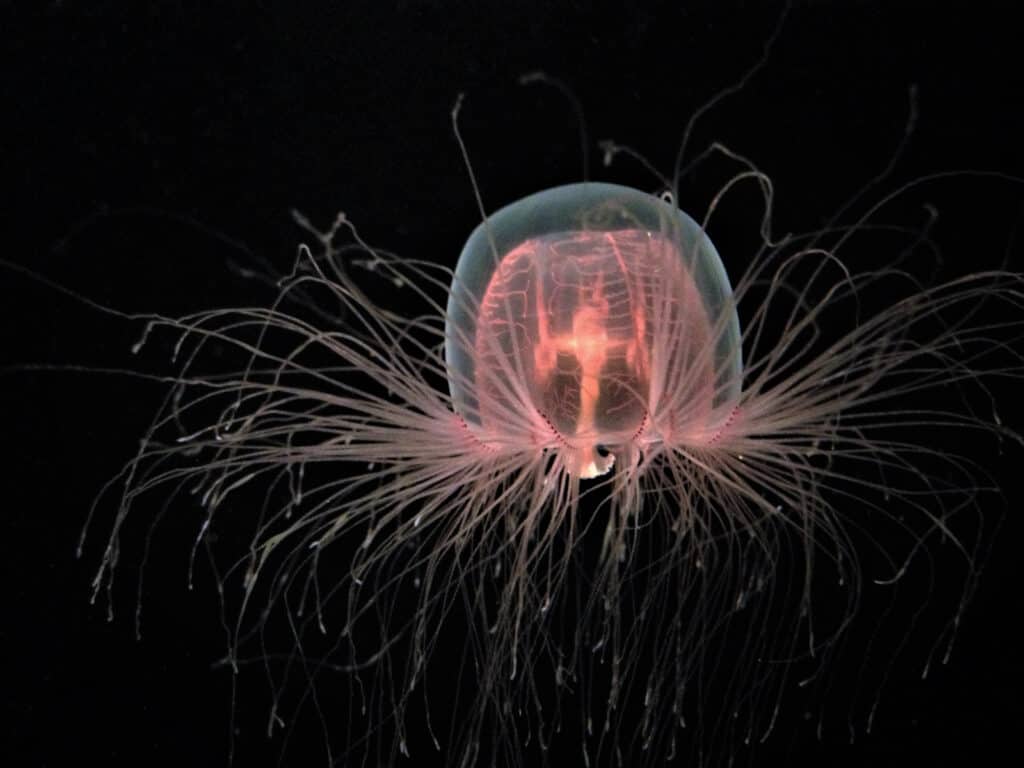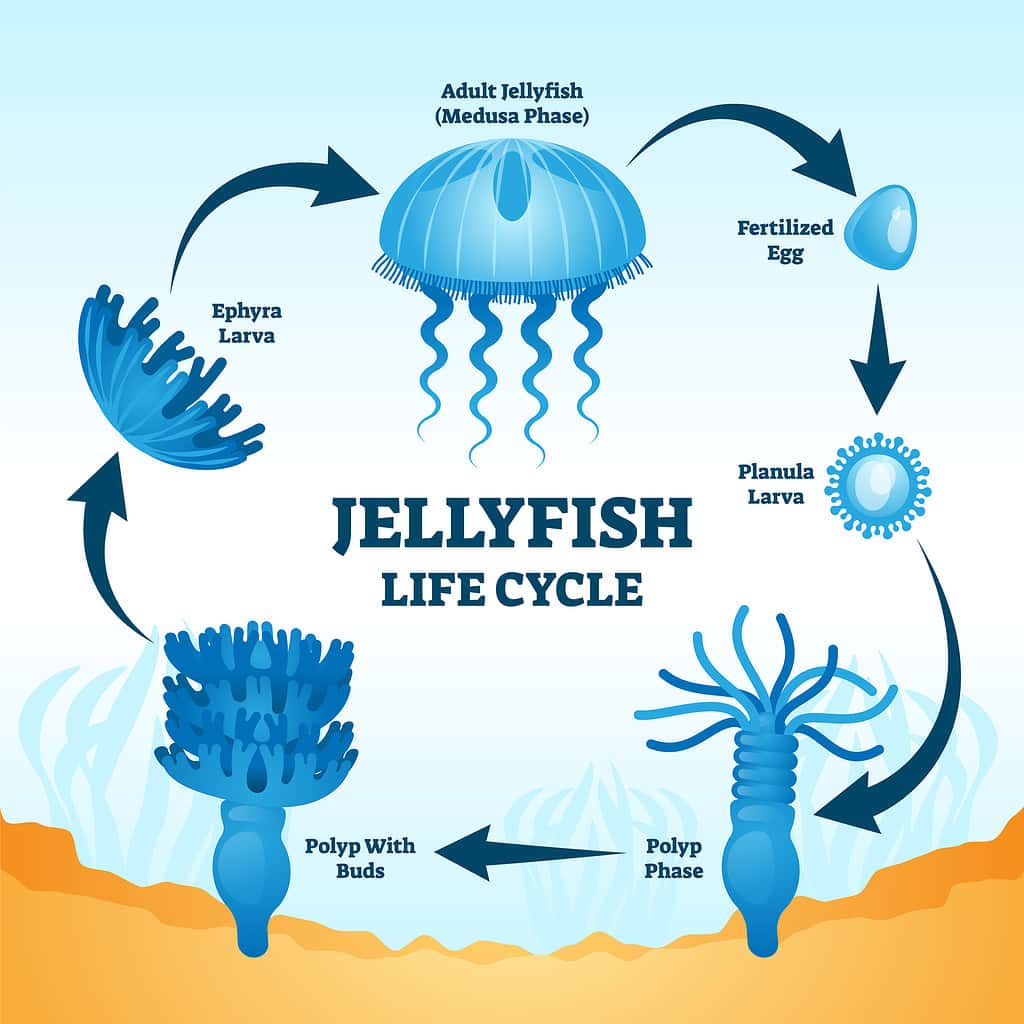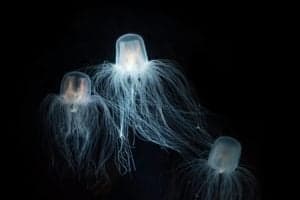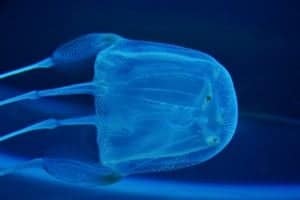The immortal jellyfish is not hiding anything behind this larger-than-life name. This invertebrate has the ability to essentially live forever. Unfortunately, since predation is highly possible, there isn’t really an average life expectancy. The immortal jellyfish is an impressive, meager creature with the possibility for infinite life, the only of its kind. If you’re wondering how these jellyfish are able to live forever, continue reading to learn more about this remarkable creature.

There are suggestions that the number of tentacles in the immortal jellyfish is related to environment.
©Rebecca Schreiner/Shutterstock.com
History of the Immortal Jellyfish
Immortal jellyfish go by the scientific name Turritopsis dohrnii and were discovered in the early 1980s. This species of jellyfish was first described about 100 years prior in 1883. These jellyfish are just 4.5 millimeters long, which equates to slightly smaller than one-quarter of an inch. They do have tiny tentacles, which appear to vary among regions. Some have eight tenacles and others have up to 90!
Though researchers first saw this species in the Mediterranean Sea, immortal jellyfish now live all over the world’s oceans. Part of this widespread range could be due to their hitchhiking nature on ships and boats. Despite their resilience, they are actually pretty sensitive creatures. In order to keep them in a live colony for studying, they need to be fed daily a diet of chopped-up brine shrimp eggs.
Life Cycle of an Immortal Jellyfish

A depiction of the typical life cycle of many jellies. Immortal jellyfish can revert back to the polyp phase.
©VectorMine/ via Getty Images
Jellyfish typically exist in two forms: the medusa form and the polyp form. The medusa form is the form we’re most familiar with: the free-floating, bell-like structure. The polyp form looks like anemones. These polyps give way to the medusa form through asexual reproduction via segmentation; the intermediate stage is called ephyra. Some species reproduce sexually, with the mature medusa releasing sperm and eggs. The fertilized eggs are called planula, and they form colonies to form more medusae.
The immortal jellyfish behaves a bit differently. They can essentially skip steps in the aging process and revert back to an “earlier” form, first to a simple bundle of tissues and then into a young polyp. From here, the life cycle can continue: polyp to immature medusa to medusa-forming planula.
They are able to skip aging steps due to stress. This type of stress can be from damage, changes in conditions, or starvation. Starvation is the stressor that gave the discoverers of this species an indication that something different was going on with these jellies. The process is called “transdifferentiation“. Previously differentiated cells can return back to an undifferentiated form, like a stem cell. That cell then turns into a different type of differentiated cell. Differentiated cells are cells that serve a specific function: for example, a muscle cell and a skin cell.
Reverting to a polyp and back into a medusa can seemingly happen an infinite number of times. In the captive colony, reversion happened up to 10 times in a two-year period. In the wild, this can likely go on forever, which gives the name “immortal jellyfish” a lot of legitimacy.
Immortal Jellyfish Predators
The immortal jellyfish certainly isn’t impervious to death. These jellies, like anything else in the ocean, can be tasty snacks for predators.
From sea turtles and sharks to anemones and other jellyfish, a slew of predators can end their life. These predators can easily eat whole colonies of immortal jellyfish before they can get a chance to explore their unique foreverness.
What Do Immortal Jellyfish Eat?
Even though these jellyfish are small, they eat quite a few different things. The obvious food of choice for their size is plankton: tiny, drifting organisms of the sea. More surprisingly, the immortal jellyfish can also eat small mollusks and fish eggs. When food is scarce, the jellyfish reverts back to a polyp stage. This polyp stage feeds like an anemone using its tentacles to catch floating ocean debris and other tiny organisms that pass by.
Can Immortal Jellyfish Make Humans Immortal?
Though it’s not completely out of the question, it’s unlikely we will find the key to human immortality in this fantastic specimen of jellyfish. There are many complexities that come with immortality. These complexities of jellyfish, and even the process of aging in humans, is not yet fully understood.
Some factors in the immortal nature of this species of jellyfish are due to the preservation of ends of the chromosomes that are called telomeres. In many animals, humans included, these telomeres protect the chromosome but get shorter after each round of cellular replication. This is one of the processes that contribute to aging.
Continuing to study the immortal jellyfish and taking the time to look into what these small organisms have to offer, can give us insight into other more complicated matters. While immortality for humans might be out of the question, researchers are more interested in solving some of the connotations of aging. This can include diseases like dementia and Parkinson’s. The more that we learn about other forms of life, the more we can learn about our own.
The photo featured at the top of this post is © Rebecca Schreiner/Shutterstock.com
Thank you for reading! Have some feedback for us? Contact the AZ Animals editorial team.






